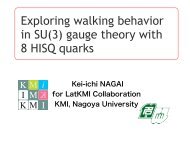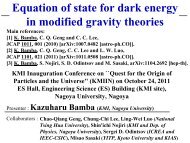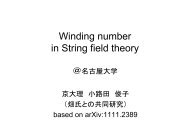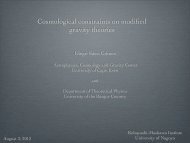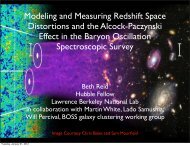Ratbay Myrzakulov
Ratbay Myrzakulov
Ratbay Myrzakulov
You also want an ePaper? Increase the reach of your titles
YUMPU automatically turns print PDFs into web optimized ePapers that Google loves.
Now we are ready to write the explicit forms of the curvature and torsion scalars. We have<br />
R = 6(Ḣ + 2H2 ) + 6ḣ + 18Hh + 6h2 − 3f 2 (3.30)<br />
T = 6(h 2 − f 2 ). (3.31)<br />
So finally for the FRW metric, the M 43 - model takes the form<br />
∫<br />
S 43 = d 4 x √ −g[F(R,T) + L m ],<br />
R = 6(Ḣ + 2H2 ) + 6ḣ + 18Hh + 6h2 − 3f 2 , (3.32)<br />
T = 6(h 2 − f 2 ).<br />
It (that is the M 43 - model) is one of geometrical realizations of F(R,T) gravity in the sense that<br />
it was derived from the purely geometrical point of view.<br />
4 Lagrangian formulation of F(R, T) gravity<br />
Of course, we can work with the form (3.32) of F(R,T) gravity. But a more interesting and general<br />
form of F(R,T) gravity is the so-called M 37 - model. The action of the M 37 - gravity reads as [10]<br />
∫<br />
S 37 = d 4 x √ −g[F(R,T) + L m ],<br />
where<br />
R = u + R s = u + 6ɛ 1 (Ḣ + 2H2 ), (4.1)<br />
T = v + T s = v + 6ɛ 2 H 2 ,<br />
R s = 6ɛ 1 (Ḣ + 2H2 ), T s = 6ɛ 2 H 2 . (4.2)<br />
So we can see that here instead of two functions h and f in (3.32), we introduced two new functions<br />
u and v. For example, for (3.32) these functions have the form<br />
u = 6(1 − ɛ 1 )(Ḣ + 2H2 ) + 6ḣ + 18Hh + 6h2 − 3f 2 , (4.3)<br />
v = 6(h 2 − f 2 − ɛ 2 H 2 ) (4.4)<br />
that again tells us that the M 43 - model is a particular case of M 37 - model [Note that if ɛ 1 = 1 = ɛ 2<br />
we have u = 6ḣ + 18Hh + 6h2 − 3f 2 , v = 6(h 2 − f 2 − H 2 )]. But in general we think (or assume)<br />
that u = u(t,a,ȧ,ä, ... a,...;f i ) and v = v(t,a,ȧ,ä, ... a,...;g i ), while f i and g i are some unknown<br />
functions related with the geometry of the spacetime. So below we will work with a more general<br />
form of F(R,T) gravity namely the M 37 - gravity (4.1). Introducing the Lagrangian multipliers<br />
we now can rewrite the action (4.1) as<br />
∫<br />
S 37 = dta<br />
{F(R,T) 3 ȧ<br />
− λ<br />
[T 2 ] [ (ä )] }<br />
− v − 6ɛ 2<br />
a 2 − γ R − u − 6ɛ 1<br />
a + ȧ2<br />
a 2 + L m , (4.5)<br />
where λ and γ are Lagrange multipliers. If we take the variations with respect to T and R of this<br />
action, we get<br />
λ = F T , γ = F R . (4.6)<br />
Therefore, the action (4.5) can be rewritten as<br />
∫<br />
S 37 =<br />
dta 3 {<br />
F(R,T) − F T<br />
[<br />
T − v − 6ɛ 2<br />
ȧ 2<br />
a 2 ]<br />
− F R<br />
[<br />
R − u − 6ɛ 1<br />
(ä<br />
Then the corresponding point-like Lagrangian reads<br />
a + ȧ2<br />
a 2 )]<br />
+ L m<br />
}<br />
. (4.7)<br />
L 37 = a 3 [F − (T − v)F T − (R − u)F R + L m ] − 6(ɛ 1 F R − ɛ 2 F T )aȧ 2 − 6ɛ 1 (F RR Ṙ + F RT ˙ T)a 2 ȧ. (4.8)<br />
7



